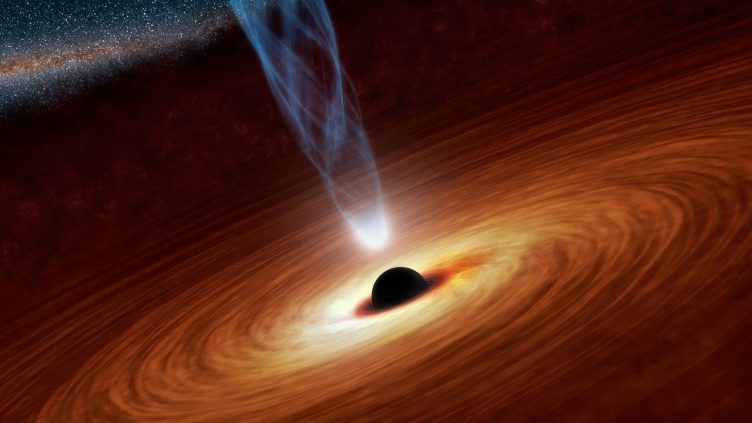An international team, with the participation of the Institute of Astrophysics and Space Sciences (IA), suggests that the mass of black holes increases with the scale of the Universe.
It is believed that almost every galaxy has a black hole at its centre with millions or even billions of times the mass of the Sun. The mass of these supermassive black holes1 grows together with that of their host galaxy, through the fall of surrounding material, or through merging with other galaxies.
However, a recent study compiled evidence that in galaxies that stopped forming stars, and thus are not feeding off pristine external material anymore, their central black hole continued to grow until having eight to 20 times more mass than expected.
“This might unveil one of the most difficult questions of the last two decades: what is the nature of this dark energy that seems today to dominate the expansion of the Universe?”
José Afonso
Now, in an article2 published in The Astrophysical Journal Letters, an international team that includes José Afonso, of the Instituto de Astrofísica e Ciências do Espaço (IA) and the Faculty of Sciences of the University of Lisbon (Ciências ULisboa) suggests an explanation for that great difference in mass between supermassive black holes in distinct moments in the history of the Universe, but that happen to be in very similar galaxies – elliptical galaxies that runned out of gas and stopped evolving, having become lethargic.
According to the researchers, this increase in the black holes’ mass is coherent with the growth of the Universe in the same time period, so that the growth of black holes might be bound to the expansion3 of the Universe itself.
“One of the suggestions that is made in this work is that black holes can explain the dark energy4 that exists in the Universe,” says José Afonso. “This might unveil one of the most difficult questions of the last two decades: what is the nature of this dark energy that seems today to dominate the expansion of the Universe? It is only a suggestion that had already been brought to attention at a theoretical level, but we are just now revealing that there are observations that support it.”
The authors support their work on theoretical models developed in the last three decades, which propose the existence of compact bodies that are alternatives to black holes. These objects avoid the physical oddities inherent to the concept of a black hole, in particular the infinite collapse that mathematically seems to be reached inside, in the so-called singularity.
“They are spherical objects that have inside a region of material with a repulsive effect, and which prevents the star from collapsing. This way, it can be seen as a stable solution that does not collapse,” explains Francisco Lobo, of IA and Ciências ULisboa. The repulsive effect inside these compact objects has something similar to the current attempts to explain the accelerated expansion of the Universe, namely the hypothesis of a dark energy – a dominant negative pressure on matter that counteracts gravity, preventing the Universe from collapsing upon itself.
The internal vacuum energy in these objects might have, according to the authors of the article, the same effect as the hypothetical dark energy, and be responsible for the accelerated expansion of the Universe. “But these theoretical objects are not actual black holes, they are alternative solutions to black holes,” says Francisco Lobo. “It is a fascinating interpretation but it will require more work in the future.”

Although the study focused on observations of supermassive black holes found at the centre of galaxies, as they are the least difficult to observe, the conclusions can be generalised to all black holes. This includes the ones created by the death of massive stars, as the end result of their explosion as a supernova, called stellar black holes. “Throughout the history of the Universe, more black holes are being created that will help to determine, or not, the expansion of the Universe at a large scale,” says José Afonso.
If this hypothesis is confirmed, not only it would be a first step to understand why the Universe is expanding, but also to explain why such huge black holes are observed in the most distant galaxies, and therefore in the first stages of the Universe’s evolution.
“We obviously intend to observe more galaxies with black holes,” says José Afonso, “and to better understand how their growth occurs, and in this way try to confirm if these black holes can really be the so-called dark energy.” To do that, the team will be using observations with the James Webb space telescope (from NASA, ESA and CSA), which precision will allow to verify if the galaxies observed in this study are in fact dormant or, on the contrary, they are still interacting with neighbouring galaxies and, by that process, acquiring new gas.
Notes
- A black hole is a body of great mass concentrated in a small region of space, in such a way that the speed needed to escape its gravitational pull is greater than the speed of light. It can be the end-of-life product of a huge star (more massive than the Sun). Once the star’s energy production runs out, the star’s material collapses under the gravity effect. Supermassive black holes are black holes that, by capturing material or stars in the surrounding environment, or by merging with other black holes, have been throughout the history of the Universe increasing their mass. Although they were first proposed in theory, there is accumulating evidence of the existence of black holes everywhere in the Universe.
- The article “Observational Evidence for Cosmological Coupling of Black Holes and its Implications for an Astrophysical Source of Dark Energy”, was published in The Astrophysical Journal Letters, Volume 944, Number 2 (DOI: 10.3847/2041-8213/acb704).
- The expansion of the Universe consists in the fact that groups of galaxies are moving away from each other, and was discovered and announced by Edwin Hubble in 1929. In the 1990s, observations of a particular type of star explosion, at different distances from us, revealed that this expansion is happening at an accelerated pace.
- Dark energy is a hypothetical force of unknown nature that could be responsible for the accelerated expansion of the Universe. If it actually exists, it has the opposite effect to that of gravity, meaning that it is repulsive and prevents matter in the Universe from making it contract and collapse upon itself. Other ways of trying to explain the accelerated expansion of the Universe involve modifications of Einstein’s Theory of Relativity, assuming that, on the scale of the entire Universe, gravity behaves differently from the local scale.
Contacts
José Afonso, Francisco Lobo
Science Communication Group
Sérgio Pereira; Ricardo Cardoso Reis; João Retrê (coordination, Lisboa); Filipe Pires (coordination, Porto).
English version by Iara Tiago.



